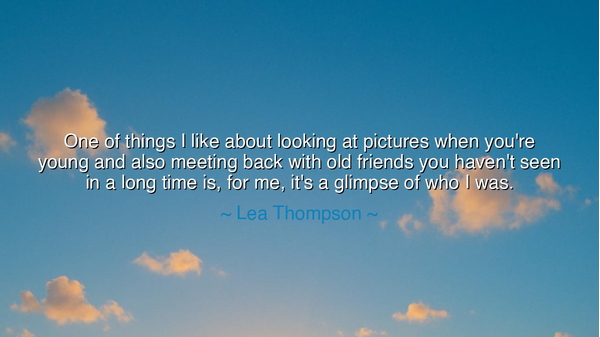
One of things I like about looking at pictures when you're young
One of things I like about looking at pictures when you're young and also meeting back with old friends you haven't seen in a long time is, for me, it's a glimpse of who I was.






Hear the tender words of Lea Thompson, spoken not with vanity but with reverence for the passage of years: “One of the things I like about looking at pictures when you’re young and also meeting back with old friends you haven’t seen in a long time is, for me, it’s a glimpse of who I was.” These words carry the bittersweet fragrance of memory, for in them lies the truth that life moves swiftly, and we, the travelers, often forget the shapes we once wore, the dreams we once carried, the faces we once knew so well.
The ancients too understood the sacredness of memory. Did not the Greeks carve images in stone, not only to honor the gods but to preserve the fleeting likeness of men and women? Did not the Romans keep wax masks of their ancestors, so that each generation might gaze upon the features of those who had gone before? For memory, whether through pictures or the fellowship of friends, is a bridge across time, giving us not only remembrance but revelation.
Consider the meeting of Odysseus and his companions after long years of wandering. When at last he returned, scarred and aged, they beheld in him both the man they had once known and the man he had become. In that moment of recognition, there was a double vision: the past alive in the present. So too, when Thompson speaks of reuniting with old friends, she speaks of seeing herself reflected back—not only as she is, but as she once was. Such moments are mirrors of the soul, revealing the continuity of life.
The glimpse of who I was is not mere nostalgia. It is a form of wisdom. For in youth, we often race forward, eager for the next horizon, blind to the shape of our own becoming. But later, in reflection, the fragments of memory join together like a mosaic, revealing how far we have traveled, how much we have endured, and how deeply we have changed. To look at a photograph, to embrace an old companion, is to remember not only the face of yesterday, but the journey that carried us from then until now.
But hear this warning, O children of time: do not despise the past self when you see it. Many are tempted to look back with regret, shame, or sorrow. Yet Lea Thompson reminds us that the past self is not an enemy but a teacher, not a stranger but a seed from which the present has grown. To see who you were is to understand more fully who you are—and to glimpse the possibility of who you yet may become.
The lesson is clear: cherish the traces of your journey. When you hold an old photograph, do not see only youth gone, but a chapter preserved. When you greet an old friend, do not see only the distance of years, but the bond that endures beyond them. These moments are gifts, windows into the mystery of identity, reminding us that we are ever-changing yet still rooted in the soil of our own story.
Practical wisdom lies before you: gather your pictures, keep them close, and let them speak to you. Seek out those you once knew, not only to rekindle affection but to remember yourself through their eyes. Reflect on the person you were, and let that reflection guide the person you are becoming. And above all, embrace both past and present, for together they form the tapestry of your life.
Therefore, let Lea Thompson’s words rest within you: “It’s a glimpse of who I was.” Take time to look back, not with regret, but with gratitude, for in those glimpses lie the treasures of memory, the wisdom of growth, and the continuity of a life worth remembering. For to know who you were is to walk more wisely into who you are yet destined to be.






AAdministratorAdministrator
Welcome, honored guests. Please leave a comment, we will respond soon